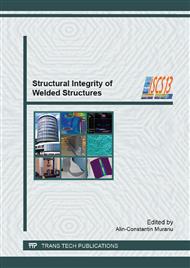p.159
p.165
p.173
p.180
p.187
p.193
p.207
p.214
p.222
Friction Stir Lap Welding of Light Alloy Sheets
Abstract:
Aluminum alloys are widely used in aerospace, automotive, railway and shipbuilding industry, as materials having remarkable properties for applications in these fields. For this reason, in recent years the interest for friction stir lap welding of sheets from these alloys increased.The behaviour of welding materials from the plastic and mechanic viewpoint are different in case of friction stir lap welding compared to friction stir butt welding.The welding tools for friction stir lap welding can have different configurations and sizes compared to butt welding. The used welding parameters must be reconsidered in order to obtain a proper flow of material for obtaining a friction stir lap welded joint.In addition, it is very important how to prepare the sheets surfaces that come into contact and their placement (relative to each other).The paper presents considerations regarding friction stir lap welding, with examples/concrete results obtained in welding of similar and dissimilar light alloys (alloys of aluminum, magnesium and titanium). It also presents data on the characteristics of obtained welded joints, related with particularities of friction stir lap welding.The obtained results showed that light alloys sheets used in various industrial fields can be joined with respect of basis conditions specific for the friction stir lap welding process.
Info:
Periodical:
Pages:
187-192
Citation:
Online since:
September 2013
Keywords:
Price:
Сopyright:
© 2013 Trans Tech Publications Ltd. All Rights Reserved
Share:
Citation:


